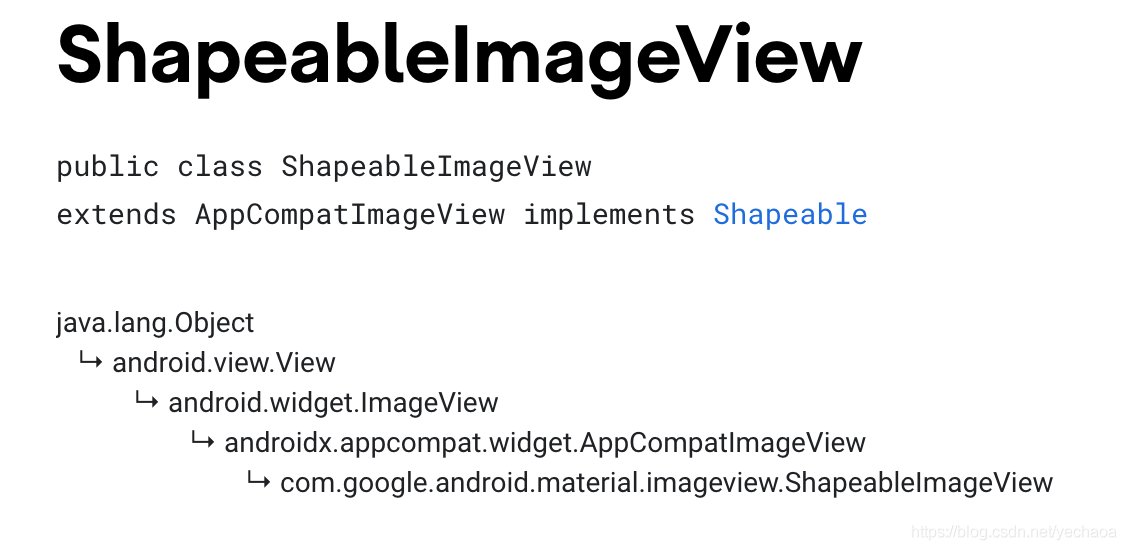Android ShapeableImageView 使用详解,告别 shape、三方库 (1)
=============================================================
先来看一下ShapeableImageView是什么

由上图可以看到ShapeableImageView也没有什么神秘的,不过是ImageView的一个子类而已,但是从效果图来看,在不写shape、不引入三方库的情况下,还是挺容易实现预期效果的,而且扩展性良好。
[](
)使用
=============================================================
[](
)引入 material 包
implementation 'com.google.android.material:material:1.2.1'
[](
)常规

<com.google.android.material.imageview.ShapeableImageView
android:layout_width="wrap_content"
android:layout_height="wrap_content"
android:layout_margin="10dp"
android:src="@mipmap/ic_avatar" />
和 ImageView 正常使用没有区别
[](
)圆角

<com.google.android.material.imageview.ShapeableImageView
android:layout_width="wrap_content"
android:layout_height="wrap_content"
android:layout_margin="10dp"
android:src="@mipmap/ic_avatar"
app:shapeAppearance="@style/RoundedStyle" />
<style name="RoundedStyle">
<item name="cornerFamily">rounded</item>
<item name="cornerSize">10dp</item>
</style>
没有直接设置圆角的属性,需要用到
app:shapeAppearance,后面会说cornerFamily 角的处理方式,rounded 圆角,cut 裁剪
cornerSize 圆角大小
[](
)圆

<com.google.android.material.imageview.ShapeableImageView
android:layout_width="wrap_content"
android:layout_height="wrap_content"
android:layout_margin="10dp"
android:src="@mipmap/ic_avatar"
app:shapeAppearance="@style/CircleStyle" />
<style name="CircleStyle">
<item name="cornerFamily">rounded</item>
<item name="cornerSize">50%</item>
</style>
圆角的大小可以用百分比,也可以自己计算,比如宽高 100dp,圆角 50dp
[](
)描边

<com.google.android.material.imageview.ShapeableImageView
android:layout_width="wrap_content"
android:layout_height="wrap_content"
android:layout_margin="10dp"
android:padding="2dp"
android:src="@mipmap/ic_avatar"
app:shapeAppearance="@style/CircleStyle"
app:strokeColor="@color/red"
app:strokeWidth="4dp" />
app:strokeColor 描边颜色
app:strokeWidth 描边宽度
注意这里 padding 的数值是描边宽度的一半,后面会说
[](
)切角

<com.google.android.material.imageview.ShapeableImageView
android:layout_width="wrap_content"
android:layout_height="wrap_content"
android:layout_margin="10dp"
android:padding="2dp"
android:src="@mipmap/ic_avatar"
app:shapeAppearance="@style/CutS
tyle"
app:strokeColor="@color/red"
app:strokeWidth="4dp" />
<style name="CutStyle">
<item name="cornerFamily">cut</item>
<item name="cornerSize">10dp</item>
</style>
cornerFamily:cut 处理模式变为裁剪
[](
)菱形

<com.google.android.material.imageview.ShapeableImageView
android:layout_width="wrap_content"
android:layout_height="wrap_content"
android:layout_margin="10dp"
android:padding="2dp"
android:src="@mipmap/ic_avatar"
app:shapeAppearance="@style/RhombusStyle"
app:strokeColor="@color/red"
app:strokeWidth="4dp" />
<style name="RhombusStyle">
<item name="cornerFamily">cut</item>
<item name="cornerSize">50%</item>
</style>
同样,裁剪模式下圆角大小也可以计算
[](
)叶子

<com.google.android.material.imageview.ShapeableImageView
android:layout_width="wrap_content"
android:layout_height="wrap_content"
android:layout_margin="10dp"
android:padding="2dp"
android:src="@mipmap/ic_avatar"
app:shapeAppearance="@style/LeafStyle"
app:strokeColor="@color/red"
app:strokeWidth="4dp" />
<style name="LeafStyle">
<item name="cornerFamily">rounded</item>
<item name="cornerSizeTopLeft">50%</item>
<item name="cornerSizeBottomRight">50%</item>
</style>
cornerSizeTopLeft 左上圆角
cornerSizeBottomRight 右下圆角
以此类推,左上、左下、右上、右下等
[](
)半圆

<com.google.android.material.imageview.ShapeableImageView
android:layout_width="wrap_content"
android:layout_height="wrap_content"
android:layout_margin="10dp"
android:padding="2dp"
android:src="@mipmap/ic_avatar"
app:shapeAppearance="@style/SemicircleStyle"
app:strokeColor="@color/red"
app:strokeWidth="4dp" />
<style name="SemicircleStyle">
<item name="cornerFamily">rounded</item>
<item name="cornerSizeTopLeft">50%</item>
<item name="cornerSizeTopRight">50%</item>
</style>
[](
)六边形

<com.google.android.material.imageview.ShapeableImageView
android:layout_width="wrap_content"
android:layout_height="50dp"
android:layout_margin="10dp"
android:padding="2dp"
android:scaleType="centerCrop"
android:src="@mipmap/ic_avatar"
app:shapeAppearance="@style/HexagonStyle"
app:strokeColor="@color/red"
app:strokeWidth="4dp" />
<style name="HexagonStyle">
<item name="cornerFamily">cut</item>
<item name="cornerSizeTopLeft">50%</item>
<item name="cornerSizeTopRight">50%</item>
<item name="cornerSizeBottomLeft">50%</item>
<item name="cornerSizeBottomRight">50%</item>
</style>
author:[yechaoa](
)
[](
)属性
=============================================================
关于 xml 属性,我也做了一个整理,属性不多,只有 4 个
| 属性 | 描述 |
| --- | --- |
| strokeWidth | 描边宽度 |
| strokeColor | 描边颜色 |
| shapeAppearance | 外观样式 |
| shapeAppearanceOverlay | 同上,叠加层 |
[](
)扩展
=============================================================
前面为了整体的排版,埋了几个伏笔,下面来一一解答。
会涉及到源码,但是经过去繁从简,看起来也非常轻松的。
[](
)shapeAppearance
Shape appearance overlay style reference for ShapeableImageView.
ShapeableImageView 的形状外观覆盖样式参考。
前面可以看到我们设置圆角其实是用的style,那为什么不直接用attrs呢,不是更加直观方便吗,带着疑问来看看源码是怎么处理的。
直接看ShapeableImageView的次构造方法:
public class ShapeableImageView extends AppCompatImageView implements Shapeable {
...
public ShapeableImageView(Context context, @Nullable AttributeSet attrs, int defStyle) {
super(wrap(context, attrs, defStyle, DEF_STYLE_RES), attrs, defStyle);
// Ensure we are using the correctly themed context rather than the context that was passed in.
context = getContext();
clearPaint = new Paint();
clearPaint.setAntiAlias(true);
clearPaint.setColor(Color.WHITE);
clearPaint.setXfermode(new PorterDuffXfermode(Mode.DST_OUT));
destination = new RectF();
maskRect = new RectF();
maskPath = new Path();
TypedArray attributes =
context.obtainStyledAttributes(
attrs, R.styleable.ShapeableImageView, defStyle, DEF_STYLE_RES);
strokeColor =
MaterialResources.getColorStateList(
context, attributes, R.styleable.ShapeableImageView_strokeColor);
strokeWidth = attributes.getDimensionPixelSize(R.styleable.ShapeableImageView_strokeWidth, 0);
borderPaint = new Paint();
borderPaint.setStyle(Style.STROKE);
borderPaint.setAntiAlias(true);
shapeAppearanceModel =
ShapeAppearanceModel.builder(context, attrs, defStyle, DEF_STYLE_RES).build();
shadowDrawable = new MaterialShapeDrawable(shapeAppearanceModel);
if (VERSION.SDK_INT >= VERSION_CODES.LOLLIPOP) {
setOutlineProvider(new OutlineProvider());
}
}
}
常规操作,获取自定义属性。
关键的两行代码:
shapeAppearanceModel = ShapeAppearanceModel.builder(context, attrs, defStyle, DEF_STYLE_RES).build();
shadowDrawable = new MaterialShapeDrawable(shapeAppearanceModel);
也就是说我们给shapeAppearance设置的 style,并不是ShapeableImageView自己来处理的,而是由ShapeAppearanceModel来构建的,然后又交给MaterialShapeDrawable来绘制的。
[](
)ShapeAppearanceModel
这个类就厉害了,有点像Flutter中的 Decoration,可以构建出花里胡哨的效果。
来看ShapeAppearanceModel部分源码:
public class ShapeAppearanceModel {
/** Builder to create instances of {@link ShapeAppearanceModel}s. */
public static final class Builder {
@NonNull
private CornerTreatment topLeftCorner = MaterialShapeUtils.createDefaultCornerTreatment();
@NonNull
private CornerTreatment topRightCorner = MaterialShapeUtils.createDefaultCornerTreatment();
@NonNull
private CornerTreatment bottomRightCorner = MaterialShapeUtils.createDefaultCornerTreatment();
@NonNull
private CornerTreatment bottomLeftCorner = MaterialShapeUtils.createDefaultCornerTreatment();
@NonNull private CornerSize topLeftCornerSize = new AbsoluteCornerSize(0);
@NonNull private CornerSize topRightCornerSize = new AbsoluteCornerSize(0);
@NonNull private CornerSize bottomRightCornerSize = new AbsoluteCornerSize(0);
@NonNull private CornerSize bottomLeftCornerSize = new AbsoluteCornerSize(0);












评论